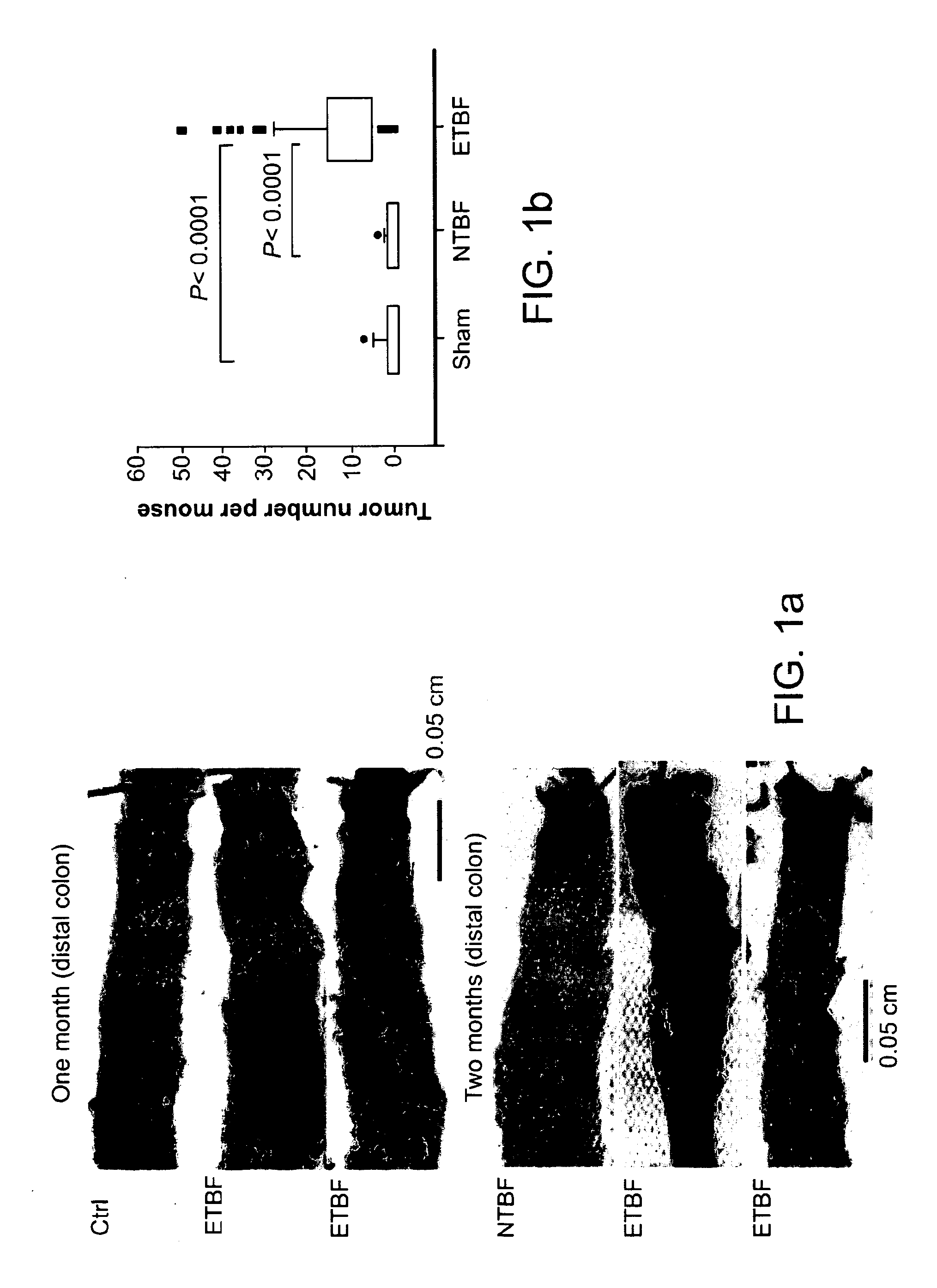Compositions and methods for treating or preventing inflammatory bowel disease and colon cancer
- Summary
- Abstract
- Description
- Claims
- Application Information
AI Technical Summary
Benefits of technology
Problems solved by technology
Method used
Image
Examples
example 1
ETBF Stimulates Rapid Colitis and Colon Tumors in Min Mice
[0174]Min mice colonized with enterotoxigenic Bacteroides fragilis, but not nontoxigenic B. fragilis (NTBF), usually developed brief diarrhea by 2-3 days, with resolution of the symptoms 4-5 days after colonization. Asymptomatic high-level colonization (≧1×109 colony-forming units per g feces) with NTBF or ETBF occurred by day 3 after infection and persisted. Only ETBF-colonized mice showed a marked increase in colonic thickness, inflammation and visible colonic tumors, especially distally, at 4 weeks or later (FIG. 1a-c and Table 1).
TABLE 1Min mouse colon histological scores 1 week and 4-6 weeksafter ETBF or NTBF colonizationMedian (range)InflammationHyperplasiaGINGross tumors1 weekSham (n = 6)0 (0-0)1 (0-1) 0 (0-0)NANTBF (n = 4)0 (0-0)0 (0-0) 0 (0-0)NAETBF (n = 16)2 (0-3)a3 (2-4)b1.5 (0-4)cNA4-6 weeksSham (n = 9)0 (0-1)0 (0-1) 0 (0-0)2 (0-8)NTBF (n = 5)0 (0-0)0 (0-1) 0 (0-0)3 (2-4)ETBF (n = 59)1 (0-3)d2 (1-4)e 1 (0-16)...
example 2
ETBF Selectively Activates Stat3 in the Colon
[0175]To address the mechanisms of ETBF-induced colitis and carcinogenesis, the activation of Stat proteins was assessed. Stat proteins are a family of transcription factors activated by cytokine receptor signaling through tyrosine phosphorylation with nuclear translocation and are central to the regulation of immune responses. Stat1 and Stat4 contribute to TH1-dependent immune responses, whereas Stat6 has a key role in TH2 responses. Stat3 transduces signals from numerous growth factor and cytokine receptors, is constitutively activated in diverse cancers and is absolutely required for TH17 cell generation while simultaneously negatively regulating TH1-mediated inflammation.
[0176]Using antibodies specific for each phosphorylated Stat protein, only phosphorylated Stat3 (pStat3) was found to be abundant in the colonic mucosa of ETBF-colonized Min mice at 2 days after infection (FIG. 2a), whereas only faint pStat3 staining was observed in s...
example 3
ETBF Induced Dominant Colonic Th17 Inflammatory Infiltrates
[0178]Stat3 signaling functions in the generation of TH17 cells, and pStat3 binds the Il17a and Il17f promoters. To determine whether pStat3 activation by ETBF colonization of Min mice initiates a TH17 mucosal immune response, FACS analysis (n=8 experiments) of isolated intraepithelial lymphocyte and lamina propria lymphocyte populations was used. This analysis showed an approximately four- to fivefold higher number of CD4+ T cells in the lamina propria of ETBF-colonized Min mice after 1 week as compared to NTBF-colonized or sham Min mice.
[0179]ETBF-colonized Min mice indeed developed a strongly skewed TH17 response characterized by equally contributory IL-17-secreting CD3+CD4+ and CD3+CD4+ effector populations in the lamina propria (FIG. 3a,b). No expanded IL-4-producing T cell effector populations were found, and the modest number of IFN-γ-producing CD3+CD4+ T cells produced low amounts of IFN-γ (FIG. 3a). In contrast to c...
PUM
| Property | Measurement | Unit |
|---|---|---|
| Biological properties | aaaaa | aaaaa |
| Level | aaaaa | aaaaa |
Abstract
Description
Claims
Application Information
 Login to View More
Login to View More - R&D
- Intellectual Property
- Life Sciences
- Materials
- Tech Scout
- Unparalleled Data Quality
- Higher Quality Content
- 60% Fewer Hallucinations
Browse by: Latest US Patents, China's latest patents, Technical Efficacy Thesaurus, Application Domain, Technology Topic, Popular Technical Reports.
© 2025 PatSnap. All rights reserved.Legal|Privacy policy|Modern Slavery Act Transparency Statement|Sitemap|About US| Contact US: help@patsnap.com



